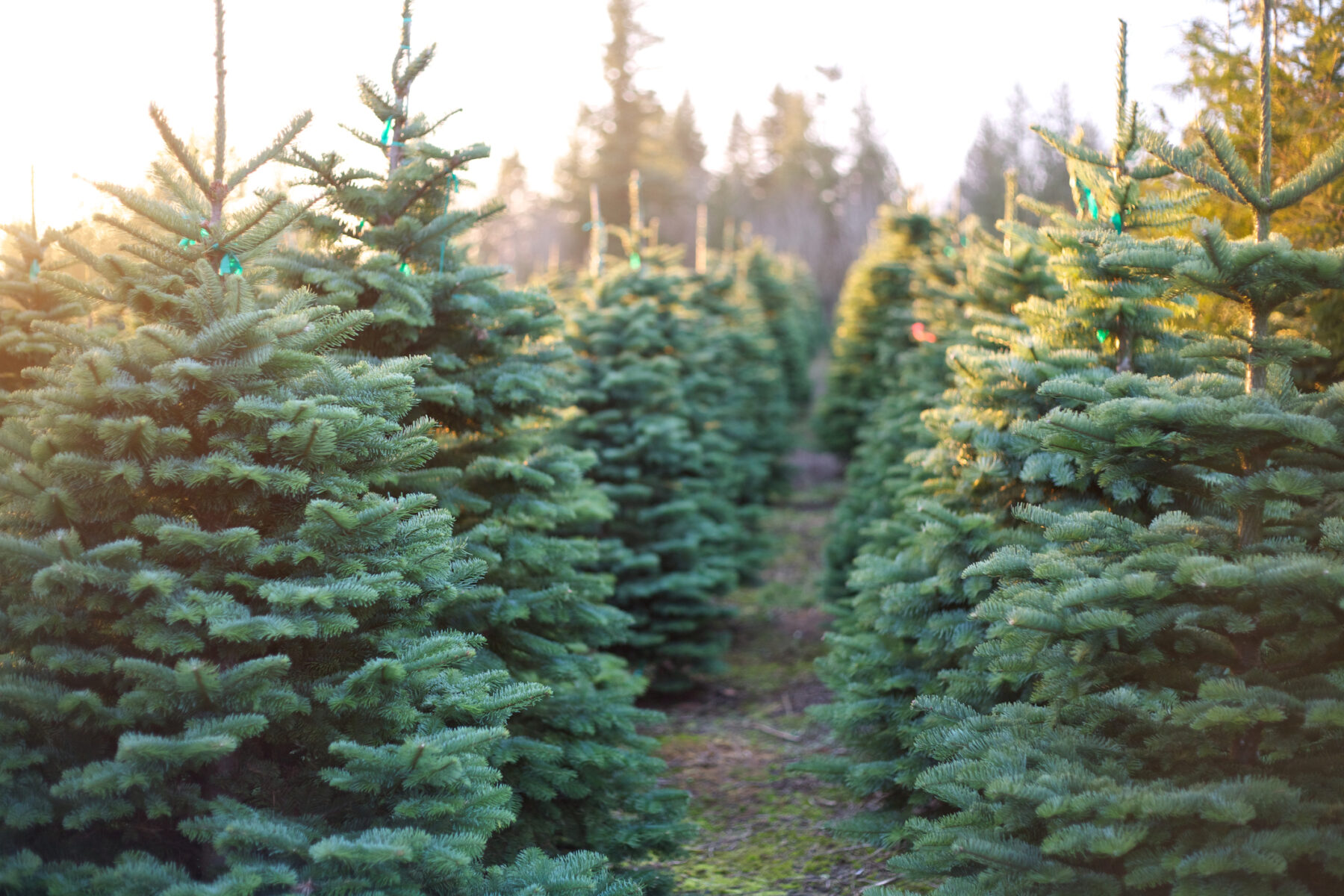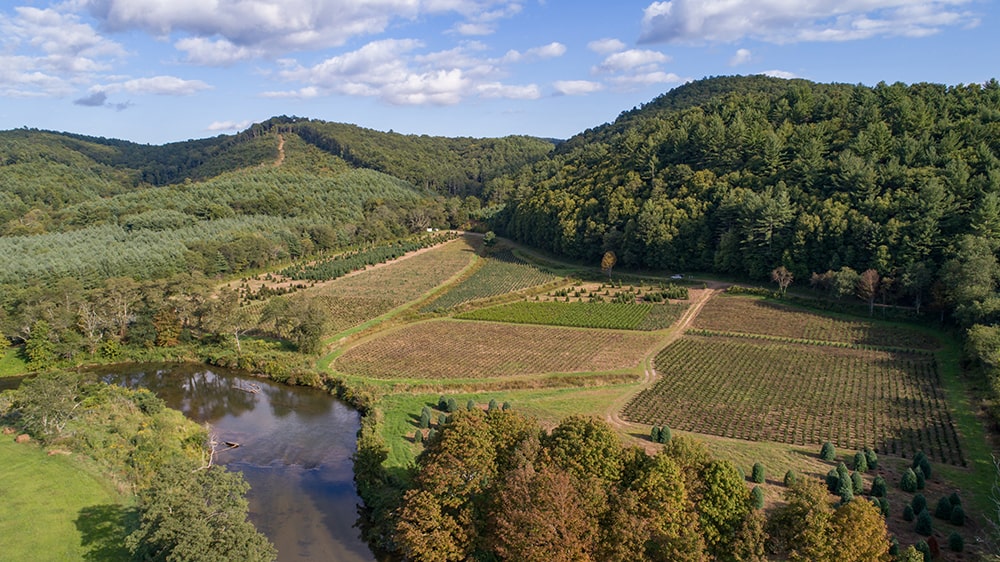
The holiday season is upon us, and with it comes a tradition that nearly 75% of Americans, or 94 million households, follow: displaying a Christmas tree. The most common variety is a Frasier fir, but others including Eastern white pine, blue spruce, and Virginia pine are also used, as well as the increasingly popular artificial Christmas tree. Of those 94 million households, 84% are using an artificial tree these days. This raises the question: which is more sustainable, a real or artificial tree?
To answer this question, we need to take a holistic view on the environmental impacts of artificial and real trees. Many of the sources we consulted compare carbon emissions for both types of trees, but we also consider wildlife value, economic impact, disposal, and more.
Greenhouse Gas Emissions
Christmas tree farms function as carbon sinks, sequestering CO2 from the atmosphere as the trees grow. It is estimated that one Christmas tree farm sequesters approximately 0.809 metric tons of greenhouse gases per acre per year during the trees’ rotation. According to the American Christmas Tree Association (ACTA), “…the GWP [Global Warming Potential] for an artificial Christmas tree is higher than the real Christmas tree,” where GWP is a measure of greenhouse gas emissions. Artificial trees produce a lot of greenhouse gasses in the manufacturing and transportation process, but because they can be reused for many years if properly cared for, they tend to break even with real trees — the key is to use them for at least 5 years.
The disposal methods for fresh trees greatly affect the amount of CO2 produced, with incineration being the worst. The best method, considering all factors, is to compost/mulch your tree. The City of Asheville will pick up Christmas trees within city limits and mulch them. You can also drop off your tree, and other yard waste, at the Buncombe County Landfill, where there is a separate disposal area where this material is ground into mulch, which residents can then purchase. If you compost at home, you can simply cut up your fresh tree (smaller pieces are better) and add to your compost. Artificial trees cannot be recycled and will eventually end up in a landfill where they will remain indefinitely as they do not readily decompose. Habitat for Humanity does accept artificial trees for re-use, even if the lights have gone out.
Habitat & Biodiversity
While Christmas tree farms are not an ideal ecosystem, given the fact that they are monocultures, some organizations make the case that they actually offer benefits to wildlife. The National Wildlife Federation highlights that they provide benefits to wildlife by offering variety in habitat type and food, especially to species that rely on young forests. In addition, NC State Cooperative Extension conducted a study in 2012-2013 to “determine the impact of ground covers on biodiversity, pollinators, and natural enemies of Christmas tree pests”. In Western North Carolina, Christmas tree growers maintain living ground covers that include species that are attractive to butterflies, bees, and predator insects that target Fraser fir pests. They conducted this study at 6 different farms over 5 different counties in Western North Carolina and found an average of 38 different species of plants present in the ground cover across all 6 farms. Many of these ground cover species include clover, goldenrod, or milkweed, which are all important species for pollinators.
The trees themselves also provide habitat for birds and cover for small mammals. While some evidence suggests that Christmas tree farms can offer benefits to wildlife, a majority of these benefits appear to come from the ground cover around the trees. Knowing if sellers are utilizing these sustainable practices would be essential for consumers to make informed purchases with the environment in mind. Also, It would be ideal to have a comprehensive study that compares the biodiversity of Christmas tree farms to other habitat types. Unfortunately, we did not find such a study. We encourage you to do further research and if you find such a resource, send it our way. As for pesticide use that may impact wildlife and humans, the amounts used have been declining as growers adapt integrated pest management practices. Overall, Christmas tree farms provide valuable habitat for a variety of species.
Economics

NC Numbers
26% of all trees in the U.S.
850 Growers
40,000 acres of farms
$86 million industry
Christmas trees produced in North Carolina are shipped across the U.S. and around the world, and tree farms represent a significant portion of North Carolina’s economy. Over 26 percent of fresh Christmas trees in the U.S. come from North Carolina, where some 850 growers produce Fraser fir on an estimated 40,000 acres. In 2017, Christmas tree sales in North Carolina generated in excess of $86 million according to the USDA Agriculture Census. A majority of these farms are owned and operated by locals, while the vast majority of artificial trees are produced in China and shipped to the U.S., significantly increasing carbon emissions overall. To minimize greenhouse gas emissions from transportation, buyers should strive to purchase a tree from a local seller.
So What’s the Answer?
While artificial trees offer the potential for reuse, the carbon emissions associated with their production and transportation cannot be ignored. Real trees, on the other hand, provide environmental benefits including carbon sequestration and wildlife habitat, and when bought locally, they support local economies and family businesses — but they are not without their concerns. The impacts from water usage, fertilizers, transportation, cultivation, and disposal are real.
According to the ACTA, artificial trees have a more favorable effect on the environment if reused for at least five years, but there are pros and cons to both real and artificial trees that must be considered and ultimately the answer for which is more sustainable, a real tree or an artificial tree, varies based on your personal priorities. If your goal is to preserve native forest habitats while reducing global energy use, an artificial tree may be a suitable option, if kept in use for years. But if you are passionate about supporting local economies, have the ability to properly dispose of your tree, or just really love the balsam fragrance of a Fraser fir, a fresh tree may be the best option for you.
Sources:
- ACTA Life Cycle Assessment. The American Christmas Tree Association (2018, March). https://www.christmastreeassociation.org/2018-acta-life-cycle-assessment
- About Real Trees. NC Christmas Trees Association (2023, June 6). https://ncchristmastrees.com/our-story/about-real-trees/
- Buncombe County. Recycling. Solid Waste – Recycling. https://www.buncombecounty.org/Governing/Depts/solid-waste/recycling.aspx?trumbaEmbed=view%3Devent%26eventid%3D156598561#!rc-cpage=476677
- Mariano, J. (2022, November 8). 75 percent of U.S. households will display A Christmas tree in 2021. The American Christmas Tree Association. https://www.christmastreeassociation.org/press-releases/75-percent-of-us-households-or-94-million-homes-will-display-a-christmas-tree-in-2021-despite-supply-chain-and-shortage-challenges#:~:text=December%209%2C%202021%20%2D%20Despite%20global,displaying%20Christmas%20trees%20in%202021%2C
- McNamara, D. J. (2022, November 29). Are real or fake Christmas trees better for the environment? The National Wildlife Federation Blog. https://blog.nwf.org/2022/11/are-real-or-fake-christmas-trees-better-for-the-environment/
- Sidebottom, J. (2019). Environmental impacts of christmas trees. NC State Extension News. https://christmastrees.ces.ncsu.edu/environmental-impacts/
- Sidebottom, J. (2013). The Pollinator Study. NC State Extension News. https://christmastrees.ces.ncsu.edu/christmastrees-pollinator-study/
- Tori Timmons, All I Want for Christmas Is a Carbon Sink, 72 HASTINGS L.J. 1347 (2021). https://repository.uchastings.edu/hastings_law_journal/vol72/iss4/10
